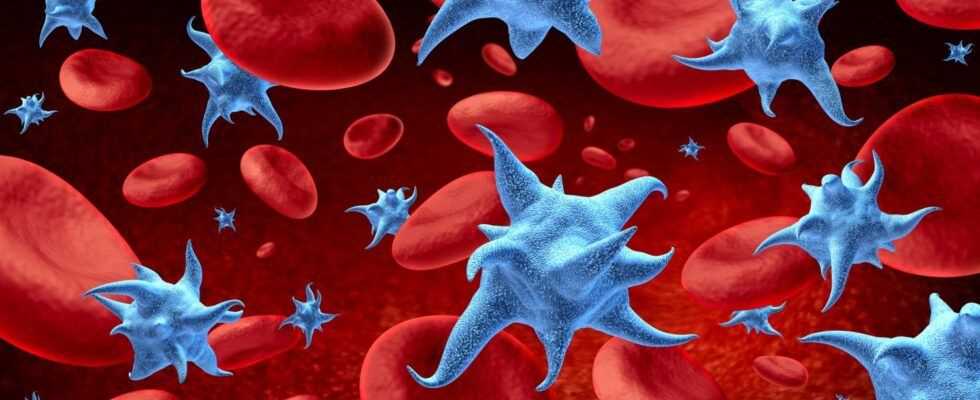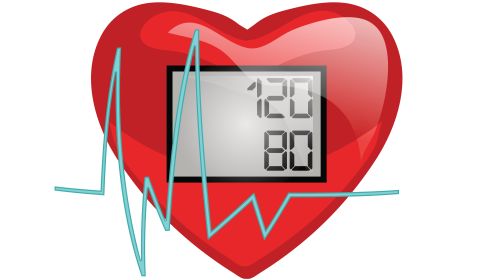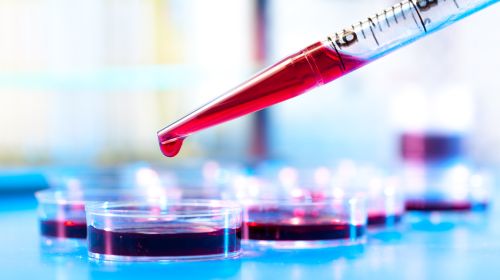Platelets are also called blood platelets. Together with erythrocytes and leukocytes (red and white blood cells), they are part of human blood. The platelets are responsible for blood clotting. Read everything about normal values, when the platelets are high or too low and what a platelet donation means.
- In the event of an injury, the platelets or blood platelets are activated and change their shape.
- © iStock.com/wildpixel
Platelets are made by special cells in the bone marrow. A platelet has a disc-shaped shape and is between one and a half and three micrometers in size. If the blood vessels are damaged, the platelets are activated and change their shape: the platelet forms protuberances, hooks and tentacles, which increases its surface area and enables it to connect with other platelets. This process is known as platelet aggregation and ensures that if there is an injury, the blood clumps, the wound is closed and the bleeding is stopped.
This blood clotting can also take place inside the body – by damaging the blood vessels. This can lead to a thrombosis – a dreaded complication, for example after surgery, which can lead to pulmonary embolism.
At a glance:
Blood thinners: Antiplatelet agents prevent thrombosis
In order to avoid pulmonary embolism, thrombosis prevention and various diseases such as arteriosclerosis or the drugs used as platelet aggregation inhibitors – commonly called blood thinners – are used. They inhibit the activity of the blood platelets and ensure a faster flow of blood through narrowed blood vessels.
When and how are platelet counts determined?
By default, the platelet count is determined from whole blood in the small blood count. Noticeable symptoms that may be related to the platelet count include:
- Bleeding that lasts for a long time
- frequent nosebleeds and bleeding gums
- Tendency to bruise
- bleeding faster than normal
Which platelet count is normal?
In healthy people, one assumes a platelet count of 150,000 to 380,000 per microliter of blood. The platelet count is determined before surgery in order to minimize bleeding complications and, if necessary, to bring the platelet count to an acceptable level beforehand. The value should be at least 50,000 – depending on the size of the procedure, higher.
What do high platelet counts mean?
If the platelet count is too high according to laboratory findings, it is called thrombocytosis. The following causes can be considered:
- Disease of the blood-forming cells in the bone marrow
- severe or chronic inflammation
- Tumors
- Removal of the spleen
Platelet counts too low
A decreased number of platelets is called thrombocytopenia. If the number of platelets is only slightly below normal, the body can usually compensate for this condition. However, if the platelet count is far below this, the blood can no longer clot properly.
Low values can be caused by an enlarged spleen or blood formation disorders caused by bone marrow tumors. The values are also lower in leukemia. If the liver is diseased (cirrhosis of the liver), the platelet count is also below normal.
The platelet count and the functionality of the cells are also influenced by medication (e.g. contraceptives, blood thinners, acetylsalicylic acid). Some diseases can also disrupt platelet function.
Platelet donation
Because of their important role in blood clotting, large quantities of platelets from donor blood are required in transfusion medicine. For example, patients with blood clotting disorders are dependent on platelet donations for treatment. The platelets are also needed in major operations, for example when using the heart-lung machine.
When donating platelets, the donor's blood is separated into its individual components, and the platelets are filtered out and collected. All other components are returned to the bloodstream. This means that platelets can ideally be donated about every 14 days. The blood donation facilities rely on particularly reliable and flexible donors because the donated concentrates only have a short shelf life and, in addition to the blood group, other blood characteristics must match those of the platelet recipient.


